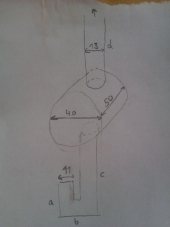Hi
What about this thought (attached image)
It is thermosiphoning, mains cold water feeds into header tank which also functions for relief of pressure and expansion.
The copper coil should be encased with very good insulation, like 150mm cellulose, where the box can be made out of sheet metal or 2 different sized barrels upside down to achieve a cavity to fill insulation.
So the copper coil has lots of surface area within a confined well insulated space to exchange the heat to water. Looks alright? Shall i have a go?
So i have regarded the expansion and pressure regulation with the header tank (not my idea, this is common old methods) that also maintains cold water delivery at all times with the float from mains pressure.
So no explosion danger!
Regarding taking energy away from the required operational heat level of the rocket,
i think by absorbing energy just from the top of barrel, it might work.
I don't think wrapping the whole barrel with a "wet jacket" will work. As you mentioned in this thread before, the rocket will struggle maintaining its temperature to be efficient.
[On conventional "slow combustion heaters" they put "wet backs" inside the firebox. Yes mad. Then the more cluey ones install another loop on top of the loop between wetback and header tank with a temp sensor and switch to determine circulation through wetback ONLY starts at a set min temperature, i think 50 celsius. Therefore the fire is not constantly hit with colder water and thus less creosote is produced.
Of course slow combustion heaters are a big compromise anyhow.]
Let me know if someone can point me out something...
Cheers
Oli







